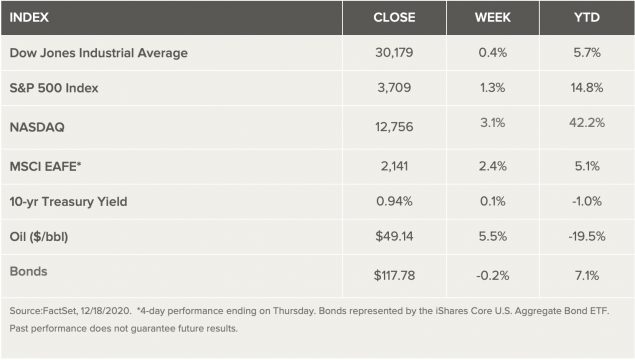Stock Markets
Stocks edged higher last week, with all major U.S. indexes hitting fresh all-time highs. Fiscal-stimulus optimism, along with a brighter longer-term outlook driven by the rollout of vaccines, continues to support sentiment. Long-term Treasury yields rose modestly, and oil logged its seventh straight weekly gain. Economic data were mixed, revealing that the economic recovery is losing some momentum amidst rising virus cases and renewed restrictions in activity. The weakness in retail sales and the recent slowdown in job growth sharpened the market’s focus on fiscal aid. Congress appears to be closing in on an agreement on a relief bill worth $900 billion. Analysts think that the proposed fiscal deal will provide the relief needed to support the economy as it makes its way to the other side of the pandemic. They say fundamentals are supportive of the longer-term outlook, but investors should anticipate bumps along the way given some of the near-term headwinds to the economy.
US Economy
Stocks breached record highs again last week, trading within a fairly narrow range that reflected a mix of encouraging and disappointing factors, as well as the typical transition toward year-end holiday market conditions. After a dramatic swing this year from a deep recession and bear-market decline to a budding economic recovery and sharp stock-market rally, the present environment is significantly more balanced1. Last week brought a swath of new information that is consistent with analysts’ view of increasingly challenging current conditions countered by an increasingly positive outlook for next year and beyond. Here’s the updated view based on what happened last week:
The pace of the economic recovery is stalling out as surging virus cases have incited renewed restrictions and lockdowns. Analysts don’t anticipate a return to deep recessionary conditions, but they think the economy will endure a soft patch in early 2021 before finding its footing as the vaccine is widely distributed, ushering in a more vibrant rebound in the second half of the year.
Metals and Mining
After starting the week at US$1,832 an ounce, the gold price rallied strongly, climbing as high as US$1,893.20 by Thursday. An uptick in value for the US dollar weighed the yellow metal down on Friday, pulling it further away from the US$1,900 threshold. The rest of the precious metals also climbed higher over the five-day period; however, palladium was unable to sustain the US$2,200 per ounce level, slipping below the mark twice before rising back. Following a month of declines, gold reached a 30 day high this session. But some of its momentum was lost late in the week as the US greenback pulled away from its year-to-date low. Gold trended lower throughout November as optimism around vaccines increased. Some of that thinking was reversed this week as positive cases of COVID-19 increased rapidly around the globe. Gold was priced at US$1,887.15 on Friday. The silver price also spent the majority of the week climbing higher, holding above US$23 per ounce. Year-to-date, the white metal has added 43 percent to its value. Silver’s ability to rise amid market chaos was recently highlighted by US Global Investors’ Ralph Aldis. Silver was trading for US$25.77 on Friday. Platinum rose to a year-to-date high this week, breaching the US$1,040 per ounce level. The price for the precious metal has been edging higher since mid-November. As mentioned, palladium experienced volatility throughout the session. Pushed as high as US$2,243 on Tuesday, it fell as low as US$2,166 on Wednesday. By week’s end, the autocatalyst metal had regained some lost ground to hold above US$2,200. Friday morning saw platinum selling for US$1,032, and palladium was sitting at US$2,224.
Economic recovery hopes continued to propel copper higher this week. The red metal surpassed its previous year-to-date high to rally to US$7,893 per tonne late in the period. Analysts remain optimistic that the base metal will benefit from the widespread vaccine rollout. Copper was holding in the US$7,900 range on Friday morning. Zinc also hit a year-to-date high this week. Since dipping to a low of US$1,773.50 per tonne in March, the zinc price has surged back 60 percent. As of Friday morning, zinc was valued at US$2,841.50. The rally continued for nickel as well, and it pushed to a year-to-date high on Monday of US$17,594 per tonne. The metal pulled back a day later but was able to end the week holding at US$17,520 on Friday. Unlike the other base metals, lead faced price pressure this week. Values hit a five day high on Wednesday of US$2,062 per tonne and have since pulled back. Lead was valued at US$2,046 on Friday.
Energy and Oil
Crude oil prices held their gains this week and pushed to new highs. In midday trading on Friday, Brent was over $52. Optimism on vaccinations is outpacing the bearish winds from record Covid-19 infections in the United States. Analysts differ on what happens next, but some say oil has more room on the upside. Having been savaged for much of 2020, stocks for North American oil and gas producers have surged in recent weeks. The Canadian Energy Sector Index is up 40% since November 9, and U.S. energy stocks are having their best quarter since 1989. LNG prices have in fact, skyrocket of late. JKM prices shot up over $12/MMBtu in recent days. Energy Intel says a combination of factors is leading to the 80% rally in just three weeks. Supply disruptions in Australia, Qatar and Norway, weather-related supply issues in the U.S., congestion at the Panama Canal, colder temperatures in the Northern Hemisphere. At the same time, Saudi Arabia cut its 2021 budget by 7%, as it seeks to minimize the damage from falling oil revenues. In a different light, after decades of stagnation and multiple false dawns, the hydrogen economy appears primed for a major takeoff. Industry experts are predicting that hydrogen could become a globally traded energy source, just like oil and gas, while the Bank of America says the industry is at a tipping point and set to explode into an $11 trillion marketplace. Natural gas spot prices rose at most locations this week. The Henry Hub spot price rose from $2.45 per million British thermal units (MMBtu) last week to $2.67/MMBtu this week. At the New York Mercantile Exchange (Nymex), the price of the January 2021 contract increased 24¢, from $2.442/MMBtu last week to $2.677/MMBtu this week. The price of the 12-month strip averaging January 2021 through December 2021 futures contracts climbed 20¢/MMBtu to $2.780/MMBtu.
World Markets
Shares in Europe rose on optimism surrounding coronavirus vaccinations, better-than-expected readings from purchasing managers’ indexes in key eurozone economies, and signs of progress in U.S. congressional negotiations for another round of fiscal stimulus. In local currency terms, the pan-European STOXX Europe 600 Index ended the week 1.48% higher, while Germany’s DAX Index rose 3.94%, France’s CAC 40 ticked up 0.37%, and Italy’s FTSE MIB added 1.26%. In London, the FTSE 100 Index ended the week down modestly, as the UK pound strengthened on earlier optimism over a trade accord with the European Union (EU). UK stocks tend to fall when the pound rises because many companies in the index are multinationals that generate significant overseas revenues.
These encouraging developments likewise appeared to reduce investor demand for assets perceived as havens, sending core eurozone bond yields higher and offsetting concerns about tougher coronavirus restrictions and Germany’s plan for hefty debt issuance next year. Peripheral eurozone bond yields ended the week flat. UK sovereign yields generally increased on growing optimism that the UK and EU could reach a trade agreement. However, dovish messaging from the Bank of England (BoE) amid an uncertain economic outlook, as well as growing worries over tighter coronavirus restrictions, somewhat curbed the rise in gilt yields.
Chinese stocks posted a weekly gain despite recording mild losses on Friday, when the U.S. announced that it was blacklisting China’s top chipmaker and more than 60 other companies for national security reasons. For the week, the large-cap CSI 300 Index rose 2.3%, while the country’s benchmark Shanghai Stock Exchange Composite Index added 1.4%.
On Friday, the U.S. Commerce Department said that it was adding Semiconductor Manufacturing International Corp. (SMIC) to its so-called Entity List, which deprives targeted companies from accessing U.S. technology ranging from software to circuitry. The addition of SMIC to the export blacklist came after the U.S. found “evidence of activities between SMIC and entities of concern in the Chinese military industrial complex,” according to the Commerce Department’s statement.
The Week Ahead
This week’s trading will be cut short by the Christmas holiday on Friday, and markets will close early on Thursday. Data being released include personal income and consumption, consumer sentiment, and new home sales.
Key Topics to Watch
- Chicago Fed national activity index
- Gross domestic product revision (SAAR)
- Consumer confidence index
- Existing home sales (SAAR)
- Personal income
- Consumer spending
- Core inflation
- New home sales (SAAR)
- Consumer sentiment index
- Initial jobless claims (regular state program, SA)
- Initial jobless claims (total, NSA)
- Continuing jobless claims (total, NSA)
- Durable goods orders Nov.
- Core capital goods orders
Market Summary


